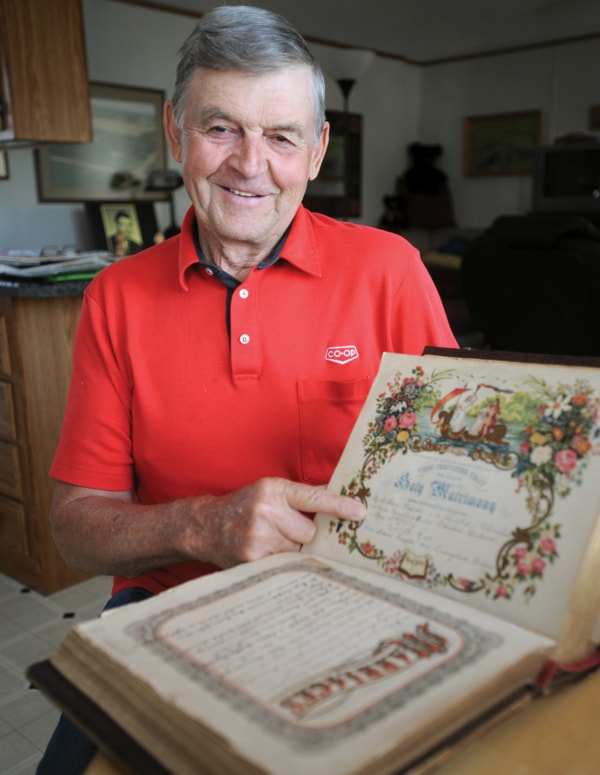John Nesom has always had a strong sense of justice — and now he knows why.
The Red Deer-area resident, who helped get two private members’ bills passed by the Alberta government, is a descendent of two of the Tolpuddle Martyrs. His ancestors were among six farm workers who stood up for fair wages in their native England in 1834 at the start of the trade union movement.
For their effort, they were shipped to an Australian penal colony.
Although their unjust seven-year sentence eventually stirred enough public outrage to prompt a pardon by King William IV in 1836, most of the so-called Martyrs returned only briefly to their native country, although they were later credited for improving British labour laws.
Five of the six immigrated to Canada, where they farmed near London, Ont.
Nesom, 76, isn’t exactly sure what brought his branch of the family to Alberta to settle near Bowden. He recalled his mother was too busy raising eight children to talk much about family history while he was growing up.
It wasn’t until Nesom was middle aged that he discovered that his grandmother was the offspring of a marriage between descendents of two of the Tolpuddle Martyrs — Thomas Standfield and James Brine.
“My mother had a book on the Tolpuddle Martyrs that I read and I started getting quite interested in it,” said Nesom. While he’d love to find out what happened to that book, which disappeared some years ago, Nesom has a Victorian Bible containing his family genealogy and marriage certificates.
He believes the men who organized a “Friendly Society of Agricultural Workers” in Tolpuddle, Dorset, were very courageous to take up the cause of farm labourers’ rights.
“I thought they were pretty nervy. They made sacrifices and really stood up for what they felt was right.”
The six men founded their society to protest against the gradual lowering of agricultural wages in the 1830s. This was caused by surplus labour during a time when mechanization was beginning to impact agricultural practices.
The Martyrs refused to work for less than 10 shillings a week, although by this time, wages had been cut to seven shillings (or about 98 cents) a week and were due to be further slashed to six.
In 1834, a local landowner wrote to Prime Minister Lord Melbourne complaining about the society. An obscure law from 1797 was invoked, prohibiting people from swearing oaths to each other — something the members of the Friendly Society had done.
James Brine, James Hammett, George Loveless, George’s brother James Loveless, George’s brother in-law Thomas Standfield, and Thomas’s son John Standfield were arrested, found guilty and deported to Australia in chains for seven years of hard labour.
What the higher powers in England could not have predicted was the popularity of the Martyrs’ cause.
Some 800,000 signatures were collected for the men’s release and their supporters organized a successful political protest march.
When it was pointed out that other British societies had also administered secret oaths — notably the Orange Lodge of which the King’s brother was a Grand Master — King William opted to extend the Martyrs his “grace and mercy and grant a free pardon.”
By the time this news reached Australia, however, the men had been imprisoned for many months.
While all of the Martyrs initially returned to England, they experienced ostracism and occasional ridicule. All but Hammett eventually opted to make the arduous cross-Atlantic journey to the Canadian colony to start over again.
“I think probably they were embarrassed by how they had been treated and they just wanted to get out of the country,” said Nesom.
In their new homes, the five Martyrs made another pact — not to reveal their past to their colonial neighbours, who might have eyed them suspiciously as former convicts.
It wasn’t until well after the men’s deaths in 1912 that their story became widely known when a memorial arch was unveiled to the Martyrs in their native Tolpuddle.
Many other honours were to follow, including a monument erected in London, Ont., as well as an affordable housing co-op/trade union complex named after the Martyrs.
Many historians believe that the sympathy generated by the Tolpuddle Martyrs’ effort to stand up for fair agricultural wages prompted improvements to laws relating to workers’ rights. This generally legitimized the trade union movement.
Nesom believes it’s an important story to remember in the days leading up to the Labour Day weekend.
While the public sometimes gets down on labour unions — and Nesom is among those who believe they could be more flexible during economically tight times — he said it’s important to remember that they helped improve wages and working conditions for millions of workers.
Nesom also feels he owes a personal debt of gratitude to his Martyr descendents for passing on a strong sense of justice though the gene pool.
Nesom brought two issues forward to former Alberta MLA Roy Brassard — his concern about physicians impeding alternative health practices in the province and his concern about unlicensed, uninsured brokers selling commodity stocks.
He said both issues were addressed in private members bills that Brassard put before the government for a successful vote.
lmichelin@www.reddeeradvocate.com
